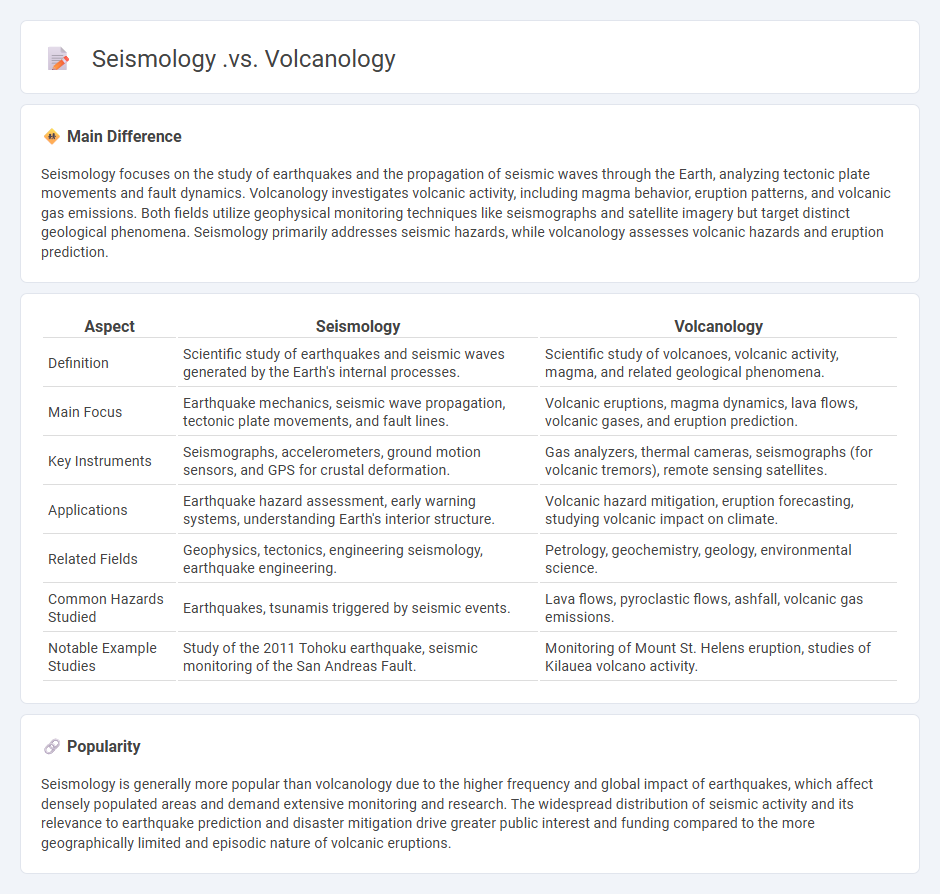
Seismology focuses on studying earthquakes and the propagation of seismic waves through the Earth's interior, analyzing fault movements and tectonic activity to understand earth tremors. Volcanology investigates volcanic activity, magma dynamics, eruption patterns, and volcanic hazards, providing crucial insights into volcanic formations and potential eruption risks. Explore the detailed differences and connections between these geoscience fields to enhance your understanding of Earth's dynamic processes.
Main Difference
Seismology focuses on the study of earthquakes and the propagation of seismic waves through the Earth, analyzing tectonic plate movements and fault dynamics. Volcanology investigates volcanic activity, including magma behavior, eruption patterns, and volcanic gas emissions. Both fields utilize geophysical monitoring techniques like seismographs and satellite imagery but target distinct geological phenomena. Seismology primarily addresses seismic hazards, while volcanology assesses volcanic hazards and eruption prediction.
Connection
Seismology and volcanology are interconnected through their focus on Earth's internal processes, as seismic activity often precedes volcanic eruptions by indicating magma movement. Seismographs detect earthquakes and tremors caused by shifting magma beneath volcanoes, providing critical data for eruption prediction. Understanding seismic patterns enhances volcanic hazard assessments, improving public safety and disaster preparedness.
Comparison Table
| Aspect | Seismology | Volcanology |
|---|---|---|
| Definition | Scientific study of earthquakes and seismic waves generated by the Earth's internal processes. | Scientific study of volcanoes, volcanic activity, magma, and related geological phenomena. |
| Main Focus | Earthquake mechanics, seismic wave propagation, tectonic plate movements, and fault lines. | Volcanic eruptions, magma dynamics, lava flows, volcanic gases, and eruption prediction. |
| Key Instruments | Seismographs, accelerometers, ground motion sensors, and GPS for crustal deformation. | Gas analyzers, thermal cameras, seismographs (for volcanic tremors), remote sensing satellites. |
| Applications | Earthquake hazard assessment, early warning systems, understanding Earth's interior structure. | Volcanic hazard mitigation, eruption forecasting, studying volcanic impact on climate. |
| Related Fields | Geophysics, tectonics, engineering seismology, earthquake engineering. | Petrology, geochemistry, geology, environmental science. |
| Common Hazards Studied | Earthquakes, tsunamis triggered by seismic events. | Lava flows, pyroclastic flows, ashfall, volcanic gas emissions. |
| Notable Example Studies | Study of the 2011 Tohoku earthquake, seismic monitoring of the San Andreas Fault. | Monitoring of Mount St. Helens eruption, studies of Kilauea volcano activity. |
Earthquakes
Earthquakes are sudden ground movements caused by the release of energy along geological faults or by volcanic activity. The Richter scale measures their magnitude, with significant events exceeding magnitude 7.0 often causing severe damage and loss of life. Regions along tectonic plate boundaries, such as the Pacific Ring of Fire, experience the highest frequency of earthquakes.
Volcanic Eruptions
Volcanic eruptions release magma, ash, and gases from Earth's mantle through volcanic vents, significantly impacting climate and ecosystems. The 1815 eruption of Mount Tambora caused the "Year Without a Summer," demonstrating how volcanic aerosols can lower global temperatures. Volcanic ash deposits enrich soils with minerals, promoting agricultural productivity in affected regions such as the volcanic highlands of Indonesia. Monitoring volcanic activity utilizing seismic data and satellite imagery improves eruption prediction and disaster preparedness worldwide.
Seismic Waves
Seismic waves are energy waves generated by the sudden release of stress in the Earth's crust, primarily during earthquakes. These waves are classified into body waves (P-waves and S-waves) that travel through the Earth's interior and surface waves (Love and Rayleigh waves) that move along the crust. P-waves, or primary waves, are compressional and travel fastest, while S-waves, or secondary waves, are shear waves that move slower and cannot travel through liquids. Understanding seismic wave behavior is critical for earthquake detection, seismic hazard assessment, and exploring Earth's internal structure.
Magma Movement
Magma movement occurs when molten rock from the Earth's mantle rises through the crust due to buoyancy and pressure differences. This process drives volcanic eruptions and forms igneous rock structures as magma cools and solidifies. The speed and path of magma movement depend on factors such as temperature, viscosity, and the presence of fractures or conduits in the crust. Monitoring seismic activity and gas emissions helps scientists predict magma movement and assess volcanic hazards.
Tectonic Activity
Tectonic activity refers to the movement and deformation of Earth's lithosphere caused by the interaction of tectonic plates. These movements result in geological phenomena such as earthquakes, volcanic eruptions, and mountain building, primarily occurring along plate boundaries like subduction zones, transform faults, and divergent margins. Earth's major tectonic plates, including the Pacific Plate, North American Plate, and Eurasian Plate, continuously shift at rates averaging a few centimeters per year. Monitoring tectonic activity through seismographs, GPS measurements, and satellite imagery is essential for understanding natural hazards and informing disaster preparedness.
Source and External Links
Could you be a Volcano Seismologist? | Department of Earth Sciences - Seismology focuses on studying all earthquakes and their properties, while volcanology specifically examines geological, chemical, and physical aspects of volcanoes and volcanic eruptions.
 calledges.com
calledges.com